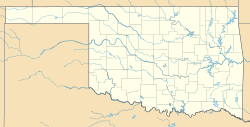Camp Nichols facts for kids
|
Camp Nichols
|
|
| Location | Cimarron County, Oklahoma, USA |
|---|---|
| Nearest city | Wheeless, Oklahoma |
| Area | 7 acres (2.8 ha) |
| Built | 1865 |
| NRHP reference No. | 66000628 |
Quick facts for kids Significant dates |
|
| Added to NRHP | October 15, 1966 |
| Designated NHL | May 23, 1963 |
Camp Nichols, also known as Fort Nichols, was a temporary fort built in 1865. It is located in Cimarron County, Oklahoma, near the town of Wheeless, Oklahoma. This fort was very important for protecting travelers on a dangerous part of the Santa Fe Trail. It was the only man-made structure on the Cimarron Cut-off section of the trail during its active use.
Contents
What Was Camp Nichols?
Camp Nichols was a military outpost built by soldiers in 1865. It was only used for a short time, from May to September of that year. The camp was named after Captain Charles P. Nichols. He was part of the First California Cavalry.
Why Was Camp Nichols Built?
The main reason Camp Nichols was built was to keep travelers safe. People used the Santa Fe Trail to move goods and travel across the country. A section of the trail called the Cimarron Cut-off was very risky. Native American tribes, like the Kiowa and Comanche people, sometimes raided wagon trains there.
Colonel Kit Carson, a famous American frontiersman, led the soldiers who built the fort. These soldiers were volunteers from New Mexico and California. Their job was to protect people and supplies moving along the trail.
Life at the Camp
Camp Nichols was built about halfway between Fort Union and the Cimarron Crossing of the Arkansas River. It was a square-shaped fort, measuring about 200 feet by 200 feet.
Inside the fort, there were six stone buildings for officers. One building served as a store for supplies. Soldiers lived in tents that had stone walls. The entire camp was surrounded by walls made of earth and stone. These walls helped protect the people inside.
A natural water source called Cedar Spring was located nearby. It was about 0.25 miles (0.4 km) west of the fort. This spring provided fresh water for the soldiers and for passing wagon trains.
What Remains Today?
Today, only the ruins of Camp Nichols can be seen. Over time, many of the stones from the original buildings have been taken away. People used these stones to build other structures.
The site of Camp Nichols is on private land. This means it is not open for the public to visit. However, you can still see parts of the old Cimarron Cut-off trail nearby. These trail remains are about 0.5 miles (0.8 km) south of the camp. Many people say they are the most impressive parts of the entire Santa Fe Trail still visible today.
Protecting History
Camp Nichols is an important historical site. Because of its history, it was named a National Historic Landmark in 1963. Later, in 1966, it was also listed on the National Register of Historic Places. These titles help to recognize and protect the site's historical value.



